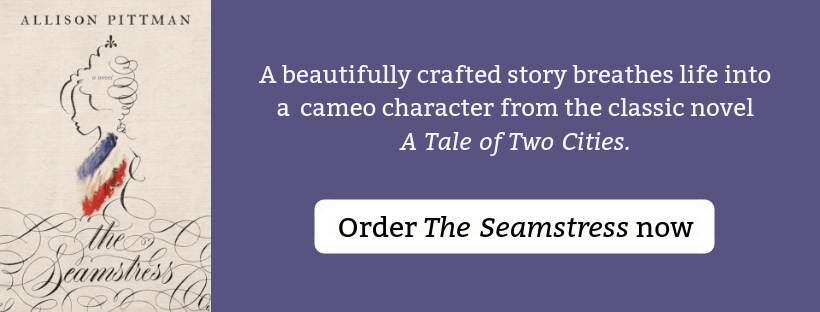Have you ever wondered where the authors of your favorite novels discover story ideas? Find out where Allison K. Pittman got the idea for her new novel The Seamstress. Read below what Allison wrote about the novel and the story behind it:
I have a unique dedication in the front of my novel The Seamstress. This one, I say, goes out to all the students who slogged through A Tale of Two Cities while I systematically quizzed and essayed and questioned away all the art from this classic work that ranks as one of my top favorites, ever. While I have consistently maintained a teaching career throughout my writing life, The Seamstress is the first novel where both of my talents and passions crossed.

People often ask, “Where did you get the idea for this story?” And often, authors’ answers begin with something like, “I’ve always wanted . . .” or “I’ve always wondered . . .” Well, not so with The Seamstress. I was standing in front of a bunch of sophomores, having a heartfelt conversation with the two or three who loved the novel as much as I do about the final sacrifice of Sydney Carton. (If you’re unfamiliar with the novel, Sydney Carton changes places with a man he physically resembles and sacrifices himself at the Guillotine.) In the scene, Carton has a conversation with a “little seamstress” who mentions having a cousin in the country, and she wonders if she will ever see that cousin again. Carton reassures her that the two will see each other again, and that—on the other side of life—there is no time there, and no trouble there. I teach at a Christian high school, so of course we talked about the promise of eternal life with Christ, and how Carton’s words assure the reader of his transformation and redemption.

But then, right in the middle of a teacher-hat moment, my mind shifted to my writer side. Yes, Dickens needed the little seamstress to give Carton a voice for his salvation, but why the cousin? Why the specifics of a cousin in the country? It’s the final paragraphs of a novel full of disparate characters. Why throw one more in? All of this I mused behind a furrowed brow and then said, out loud, “I should write that story. The Seamstress and Her Cousin.” By the time the bell rang to end class, Renee, Laurette, Gagnon, and Marcel were fully formed.
The idea remained buried, alive, for years while I devoted myself to Katherina Luther. But then, in a flurry of messaging with friend and (now) agent Rachel McMillan, The Seamstress was, to use a phrase from A Tale of Two Cities, “recalled to life.” Right where I left her. I remembered the story—my story—from end to beginning and beginning to end. I’m excited for readers to catch my vision, but I hope, too, that some will be enticed to open up the classic novel where my Seamstress first peeks out from a page.
The Seamstress by Allison K. Pittman
A beautifully crafted story breathes life into the cameo character from the classic novel A Tale of Two Cities.
France, 1788
It is the best of times . . .On a tranquil farm nestled in the French countryside, two orphaned cousins—Renée and Laurette—have been raised under the caring guardianship of young Émile Gagnon, the last of a once-prosperous family. No longer starving girls, Laurette and Renée now spend days tending Gagnon’s sheep, and nights in their cozy loft, whispering secrets and dreams in this time of waning innocence and peace.
It is the worst of times . . .
Paris groans with a restlessness that can no longer be contained within its city streets. Hunger and hatred fuel her people. Violence seeps into the ornate halls of Versailles. Even Gagnon’s table in the quiet village of Mouton Blanc bears witness to the rumbles of rebellion, where Marcel Moreau embodies its voice and heart.
It is the story that has never been told.
In one night, the best and worst of fate collide. A chance encounter with a fashionable woman will bring Renée’s sewing skills to light and secure a place in the court of Queen Marie Antoinette. An act of reckless passion will throw Laurette into the arms of the increasingly militant Marcel. And Gagnon, steadfast in his faith in God and country, can only watch as those he loves march straight into the heart of the revolution.


